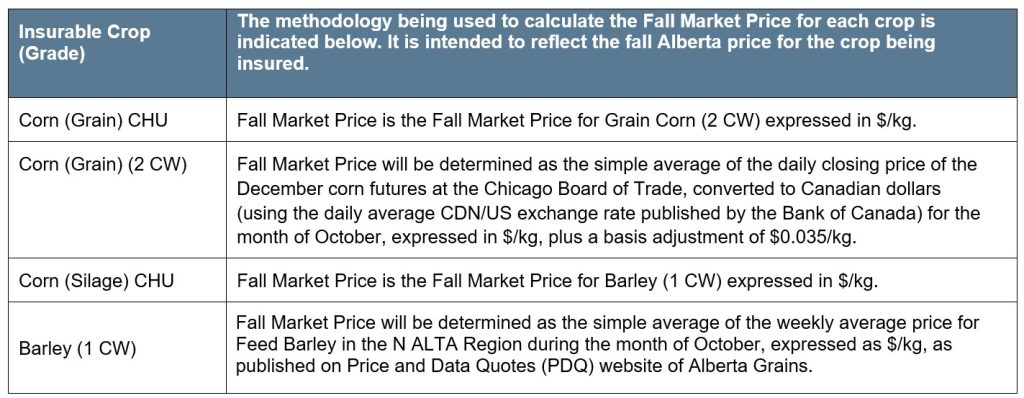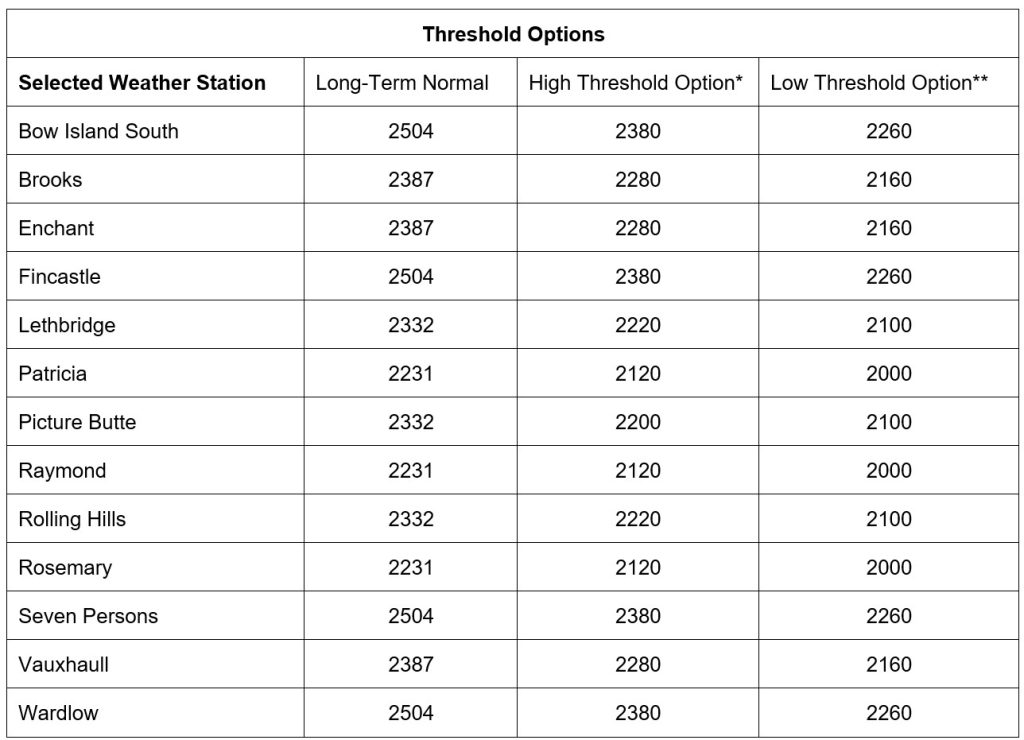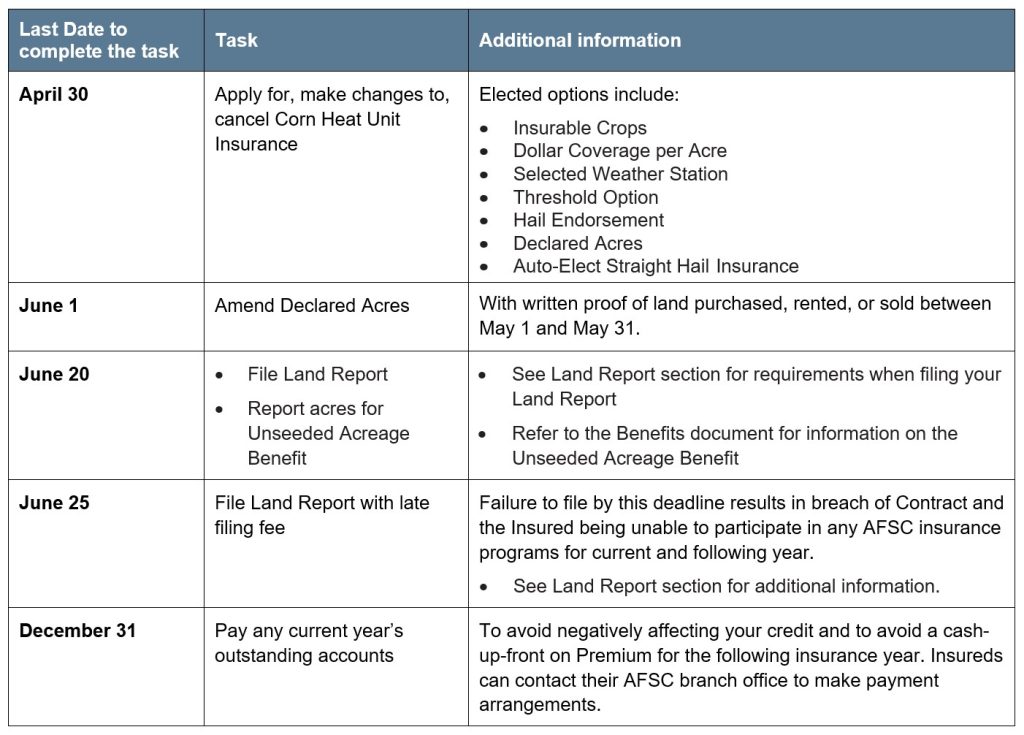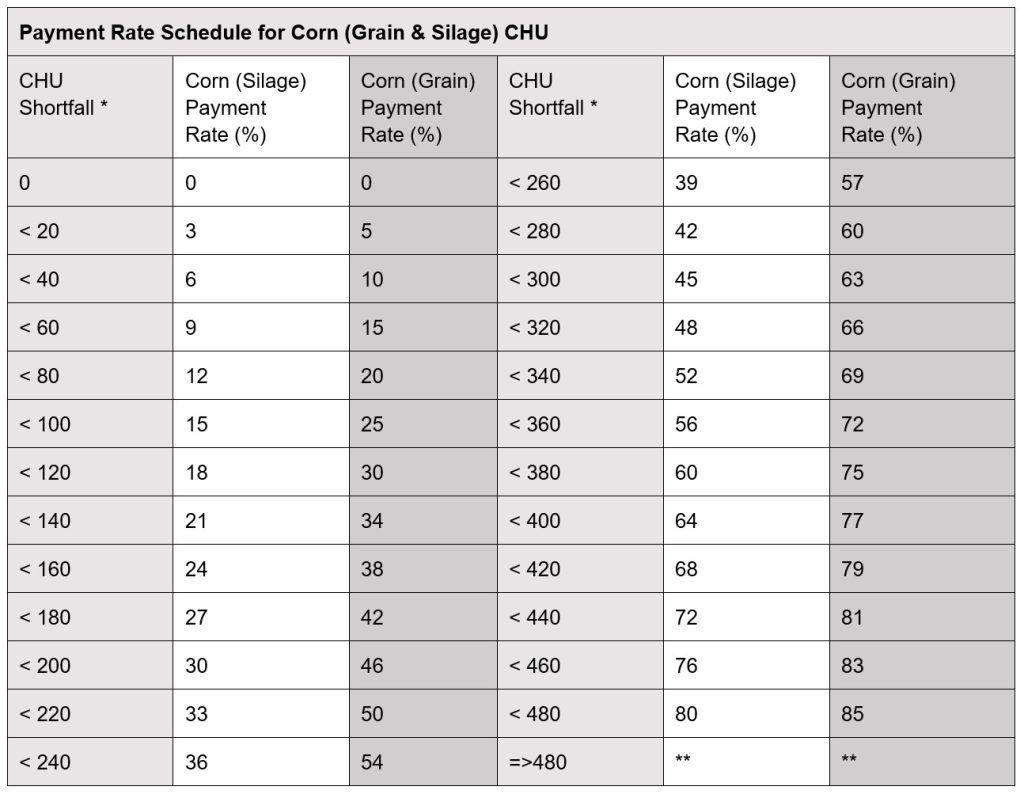Corn Heat Unit Insuring Agreement 2025
Corn Heat Unit Insuring Agreement
AFSC will indemnify the Insured against Annual Corn Heat Units being less than the Threshold Corn Heat Units elected by the Insured, at a Selected Weather Station for the Insured’s Corn (Grain) or Corn (Silage), pursuant to this Insuring Agreement. This Insuring Agreement incorporates by reference, and is subject to, the Terms and Conditions and Benefits. The definitions in the Terms and Conditions will apply unless the same term is otherwise defined in this Insuring Agreement.
Corn Heat Unit Insurance is an area-based program that provides protection against a lack of heat for irrigated corn. Actual production of corn on the farm does not affect a claim payment.
“Insurable Crop” means Corn (Grain) or Corn (Silage).
“Annual Corn Heat Units” means the accumulated Corn Heat Units at the Selected Weather Station for the current year.
“Corn Heat Units” means an energy term calculated from daily maximum and minimum temperatures and accumulated from May 15. The accumulation of Corn Heat Units stops on the earlier of:
a. the first day on which the minimum temperature of minus two degrees Celsius or less occurs after 700 Corn Heat Units have accumulated, or
b. September 30.
“Designated Peril” means the difference between the Threshold Corn Heat Units and the Corn Heat Units at the Selected Weather Station with a provision of a late frost in the spring. For greater clarity, this is the only Designated Peril under this Insuring Agreement and the Designated Perils listed under Article 1 of the Terms and Conditions do not apply to this Insuring Agreement.
“Dollar Coverage per Acre” means the amount of dollar coverage, elected by the Insured from a minimum of $100 to a maximum value set annually by AFSC.
“Corn (Grain)” means corn seeded for grain production.
“Corn (Silage)” means corn seeded for silage production.
“Payment Rate” means the rate of compensation at which the Insured is indemnified, as determined by AFSC.
“Selected Weather Station” means an eligible weather station elected by the Insured and approved by AFSC.
“Threshold Corn Heat Units” means the total Corn Heat Units, assigned by AFSC, at the high and low threshold options for the Selected Weather Station, below which insurance payments begin.
a. The Insured must elect the Dollar Coverage per Acre in increments of $25 from a minimum of $100 per acre to a maximum value set annually by AFSC using the Spring Insurance Prices for Corn (Grain) and commercial barley for silage.
a. AFSC will use daily minimum and maximum temperatures provided by Alberta Government ministry responsible for Agriculture, or by Environment Canada, at all weather stations approved by AFSC for this Insuring Agreement. If AFSC is not able complete the assessment due to insufficient data being provided, this Insuring Agreement will cease to be enforceable against AFSC and cease to have any effect against AFSC. AFSC will then return to the Insured all paid Premium.
a. Corn Heat Units are calculated from temperature measured at the insurable weather stations on a daily basis beginning on May 15. Corn Heat Units for the growing season are the total of the daily calculations. After a minimum of 700 Corn Heat Units have accumulated, the daily calculations continue to accumulate until the earlier of the first killing frost, defined as a temperature of less than or equal to -2°C, or September 30.
b. The Celsius-based formula used to calculate daily Corn Heat Unit is:
[1.800 (C1 – 4.4) + 3.330 (C2 – 10) – 0.084 (C2 – 10)^2] ÷ 2, where:
i. C1 is the daily Celsius minimum temperature (set at 4.4 if C1 is less than 4.4); and
ii. C2 is the daily Celsius maximum temperature (set at 10 if C2 is less than 10).
iii. The lowest daily value for a CHU is 0.
a. Insurable Crop(s) grown on irrigated land must meet the following conditions:
i. those crops are declared as irrigated;
ii. there is an adequate source of water;
iii. the Insured has reliable irrigation equipment;
iv. adequate irrigation water is applied on a timely basis; and
v. the Insured maintains an up-to-date log showing the dates and approximate amounts of rainfall and irrigation water applied to each Insured Crop.
a. Spring Insurance Price: In the spring, AFSC forecasts expected crop prices for the coming Crop Year. For this Insuring Agreement, it is equal to the Spring Insurance Price for Grain Corn (2CW) for Corn (Grain) CHU, and Barley (1CW) for Corn (Silage) CHU.
b. Fall Market Price: In the fall, AFSC reviews the pricing using specific methodologies, as described in the table below, to determine whether the crop’s Fall Market Price is substantially lower or higher than the Spring Insurance Price and sets Fall Prices accordingly.
c. Variable Price Benefit: is offered to protect against price fluctuations between the Spring Insurance Price and the Fall Price. Refer to the Benefits document for information.
The Variable Price Benefit triggers when the Fall Price of an eligible crop increases by a minimum of 10% above the Spring Insurance Price, and compensates when the Policy has received an Indemnity.
Market Price Methodology Table
In the event that price information originating from published Fall Market Price methodology for an Insurable Crop(s) is not available or stops being available during the Fall Market Price period, at its best discretion, AFSC maintains the right to develop and implement an alternate price methodology for Fall Market Price determination to replace or augment pricing for that crop(s) in that year.
a. Minimum Premium: There is a minimum $25 of total Premium required per insurance Policy.
b. Rates: Premium rates are set annually and reflect AFSC’s risk of future losses. For Corn Heat Unit Insurance, premium rates are based upon historical corn heat unit data at the low threshold option. A risk factor is used to set premium rates for the high threshold option.
c. Cost Share: Federal and provincial governments support AgriInsurance programs by paying all administration expenses and sharing premium costs with the Insured.
d. Adjustments & Discounts:
a. Application: New clients must apply for insurance on or before April 30 and AFSC will evaluate eligibility for insurance. Producers are required to demonstrate their legal, financial and operational independence, and can contact AFSC for application documents.
b. Renewal Process: Insurance remains in effect from year to year therefore an Insured who elected Corn Heat Unit insurance in the previous year will be automatically renewed based upon the previous year’s information. Personalized renewal notices will be available in March. The Insured is responsible to review the information, and if changes are required, complete a change request form and return the form to an AFSC insurance representative by mail, fax, email, in person, or request changes by phone, no later than April 30.
c. Selected Weather Station: The Insured can choose an insurable weather station near their farm that best represents temperatures on their farm.
d. Insurable Crops and Dollar Coverage: The Insured must select the crops they want to insure and dollar coverage per acre in increments of $25 from a minimum of $100 per acre to a maximum dollar value per acre for:
i. Irrigated Corn (Grain) of $525
ii. Irrigated Corn (Silage) of $975
e. Declared Acres: are the total number of acres seeded and those intended to be seeded to Annual Crops, including Silage and Greenfeed crops, whether the acres are to be insured or uninsured
f. Hail Endorsement: offers spot-loss coverage and may be elected with Corn Heat Unit Insurance by April 30. Refer to the Hail Endorsement Insuring Agreement for additional information.
g. Auto-Elect Straight Hail Insurance: may be elected with Corn Heat Unit Insurance by April 30. When elected, a two percent premium discount will be applied on the Straight Hail Statement of Coverage and Premium.
Straight Hail Insurance can be purchased on a field-by-field basis until July 31. Refer to the Straight Hail Contract of Insurance for additional information.
h. Threshold Option: The Insured can choose between a high or low threshold option.
Payments begin sooner under the high threshold option, therefore the premium for this option is higher than for the low threshold option.
a. The Insured must elect the same high or low threshold option for Corn (Grain) and for Corn (Silage).
a. The Insurable Crop shall be grown on irrigated land and shall be irrigated only by a pivot system.
b. The Reseeding Benefit and Unharvested Acreage Benefit are not available under this Insuring Agreement.
If a reporting deadline date falls on a weekend, the deadline will be extended to the next Business Day.
Other Important Deadlines
a. All eligible acreage and seeded acreage of an elected Insurable Crop, whether owned, rented or crop-shared, must be insured. Acres insured under this Insuring Agreement are not insurable under any other crop insurance program, except for applicable Endorsements or where AFSC has consented in writing.
Cash rent and crop-share landlords are not eligible for insurance as they are not responsible for the agronomic decisions and do not receive the majority of the proceeds from the sale of the crop.
b. If AFSC determines acres of an Insured Crop and the crop type and/or acres differ from those reported by the Insured, the following will apply:
i. When completing unseeded inspections AFSC will issue a revised Statement of Coverage and Premium based on the crop type and actual number of seeded acres calculated by AFSC and any Indemnity calculation shall be based on the crop type and actual acres.
c. AFSC is not required or in any way obligated to revise or adjust its calculation of insured acres for any preceding year.
a. A Land Report must be filed once seeding is finished and no later than June 20.
b. The Insured must report all annual spring and fall crops on land that is owned, rented, or crop-shared and include the following information for each field:
i. legal land description for the location including the part;
ii. seeding date;
iii. crop type seeded;
iv. number of seeded acres;
v. report acres too wet to seed by quarter section, including whether fertilizer had been incorporated or not, and if the land is irrigated or not.
c. Failure to file a Land Report will result in all insurance Policies being cancelled and restrictions on future year’s program participation. Where the Insured fails to file a Land Report by the June 20 deadline AFSC may, in its discretion:
i. accept the Land Report, if received by June 25, and assess a late filing fee to be paid by the Insured in full before the start of the next crop year;
ii. if due to extenuating circumstances, AFSC has the discretion to determine the acreage seeded by the Insured and file a Land Report for the Insured which shall be binding on the Insured; or
iii. cancel this Contract or any part thereof for the current Crop Year, in which case the Insured will be unable to participate in any AFSC insurance programs for the current and following year with the following exceptions:
1) Livestock Price Insurance can be purchased in the current year; and
2) Straight Hail Insurance can be purchased in the following year.
d. AFSC reserves the right to reject requests for changes to the Land Report after the June 20 filing deadline.
a. Information provided by the Insured is used to generate a Statement of Coverage and Premium, which explains Coverage and Premium and states AFSC’s Coverage limit.
b. The Insured should review their Statement of Coverage and Premium carefully to ensure it is complete and accurate. Errors and omissions must be reported to AFSC within 15 calendar days of receipt.
c. AFSC reserves the right to deny additional Coverage when information contained on the Statement of Coverage and Premium reflects what is reported on the Land Report.
a. The Insured is not required to submit a Notice of Loss to initiate a claim for Designated Perils under this Insuring Agreement.
b. The Insured is required to submit a Notice of Loss to initiate a claim and the deadline to initiate a claim are as follows:
i. Unseeded Acreage Benefit: contact AFSC on or before June 20.
ii. If the Insured is late in filing a Notice of Loss AFSC may reject the claim.
a. Upon receipt of a claim for loss:
i. where AFSC processes a claim, AFSC will serve the Insured with a Statement of Loss
ii. where AFSC’s process is to conduct an inspection, following the inspection, AFSC will serve the Insured with a copy of the Inspection Report.
b. If the calculation of a claim for loss results in no payment, the Statement of Loss will be considered the final Statement of Loss for the claim by the Insured and no further Statement of Loss will be issued by AFSC.
c. If the Inspection Report results in no payment, or if as a result of the Inspection Report the claim for loss is withdrawn by the Insured, the Inspection Report will be considered to be the final Statement of Loss for the claim by the Insured and no further Statement of Loss will be issued by AFSC.
d. If the Insured does not, within seven days of service of the Inspection Report, advise AFSC of the Insured’s disagreement with the report or does not request a re-inspection, AFSC will issue the Statement of Loss according to the Inspection Report.
a. After an inspection, pursuant to Section 8.02 (d) if the Insured, within seven days of service of the Inspection Report:
i. advises AFSC of the Insured’s disagreement with the report; and
ii. requests a re-inspection:
AFSC will conduct a re-inspection, and no Statement of Loss will be issued until after the re-inspection has been conducted. AFSC reserves the right to charge a fee for Insured requested re-inspection of crops, or re-grading of samples.
a. The procedures set out in AFSC’s adjusting procedure manuals shall be used in the assessment of an insurable loss of an Insured Crop.
AFSC recommends the Insured or Authorized Representative accompany adjusters during on-farm inspections.
a. Service of the Statement of Loss may be effected on the Insured by:
i. personal service;
ii. ordinary mail or registered mail, in which case service is deemed to have been effected;
1) seven days from the date of mailing if the document is mailed in Alberta to an address in Alberta, or
2) 14 days from the date of mailing if the document is mailed to an address located outside of Alberta; or
iii. by facsimile, email or other electronic means in accordance with AFSC’s most recent records for the Insured.
b. Where there is more than one Insured in respect of the crop loss for which an inspection has been made, service of the Inspection Report or Statement of Loss on one of the Insured is deemed to be service on all the Insureds.
a. To facilitate tax planning, Insureds can choose in advance to defer Indemnities to the following tax year. There will be no recourse to defer payment once a payment has been issued. Deferred Indemnities will not be applied to outstanding Premiums/balances until the deferred date and interest will continue to accrue.
a. An Indemnity for each Insurable Crop shall be calculated as follows:
[Dollar Coverage per Acre x Insured Acres x Payment Rate]
The maximum Indemnity payable shall be 100% of the Dollar Coverage.
b. The Payment Rate will be based on the Insured’s elected high or low threshold option and the Insured’s Selected Weather Station.
i. The Payment Rate for the Insured’s Selected Weather Station will be zero when the Annual Corn Heat Units is equal to or more than the elected Threshold Corn Heat Units.
ii. Where the Annual Corn Heat Units is below the elected Threshold Corn Heat Units, the Payment Rate will be based on the Payment Rate schedule published by AFSC at the time of the election.
c. Adjustment for Late Spring Frost
i. If minimum temperature at the Specified Weather Station falls below zero Celsius on or after June 1 and before 700 Corn Heat Units have accumulated, AFSC will make an adjustment for a late spring frost to the Annual Corn Heat Units at that weather station and reduce it by an amount equal to:
{(number of days after June 1 to the last day that the minimum temperature fell below zero Celsius) x (15 Corn Heat Units) + (50 Corn Heat Units)}.
d. Except at the discretion of AFSC, no changes will be made to the Corn Heat Units calculations after an Indemnity has been paid.
e. In no case, for an Insured Crop, shall the combined Indemnities under any Insuring Agreement (including Hail Endorsement) exceed total Dollar Coverage for that crop under this Contract.
*The CHU shortfalls shown in the table are after adjustments for late spring frost (if required)
**Insureds with CHU shortfalls of 480 or more may be eligible for a larger payment if indicated by inspection








